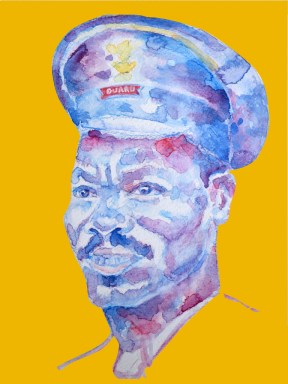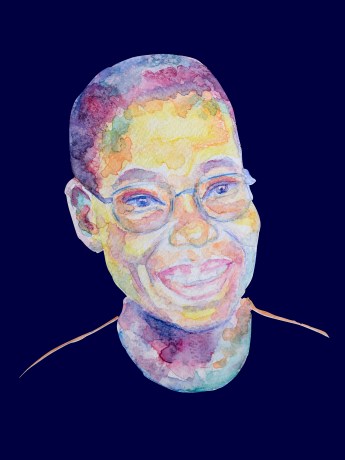“A people without knowledge of their past history, origin and culture is like a tree without roots.”
Marcus Garvey
Pictures have power: did you know that people are more likely to remember pictures than words? But that’s assuming you even have the chance to see the pictures.
Over one million biographies on Wikipedia do not have images—and because search engines tend to drive more traffic to Wikipedia articles with images than those without, we know that these biographies are more likely to be left unread, their stories untold and faces unseen.
Without images, we are missing out on an additional point of entry for visual learners and opportunities to expand understanding of the information Wikipedia is presenting.
Enter Wiki Unseen, a Wikimedia Foundation project in partnership with AfroCROWD.org, local artists, and Behance, the world’s largest creative network for showcasing and discovering creative work. Together, we will be expanding the visual representation of Black, Indigenous and people of colour (BIPOC) in Wikimedia projects. This work will advance knowledge equity, and we’re hoping to see its model replicated across our shared movement. By commissioning these works and releasing them under a Creative Commons Attribute Sharealike license, they will be freely usable on Wikipedia… or anywhere else in the world.
Launching on 9 February, the first iteration of the project features a collaboration with artists from Africa, North America, and the Caribbean. The Wikimedia Foundation and AfroCROWD worked together to select 20 Wikipedia articles of historical figures from the African Diaspora without visual representation from a list of the top 2000 regularly visited BIPOC biographies. Foundation staff then worked with Behance to compile a list of artists who hailed from the same regions as the historical figures. We selected three artists, who then each chose to illustrate 2 out of the 20 biographies.
“The lack of visibility and understanding of these histories within the wider media ecosystem constrains how BIPOC communities are portrayed in the news, education, pop culture, the arts, and more. This contributes to discriminatory bias and stereotyping in media, business, and other sectors of daily life, and perpetuates those histories’ continued exclusion from the collective memory.”
Sherry Antoine, the Executive Director of AfroCROWD.org.
The commissioned artists include ballpoint pen artist Enam Bosokah from Ghana, Esther Griffith from Trinidad and Tobago, and multidisciplinary artist Bukhtawar Malik from the United States. Among the first articles that will feature new illustrations are Ghanaian biochemist and educator Marian Ewurama Addy, documentary filmmaker William Greaves, Senegalese computer scientist Rose Dieng-Kuntz, American poet and playwright May Miller, Jamaican astronomy and astrophysics professor Mercedes Richards, and Dominican Asquith Xavier, who fought racial segregation in England to become the first Black train guard at Euston railway station. These portraits will be uploaded to Commons and shared throughout the month with the aim of adding them to the articles on Wikipedia.
You can access a social media toolkit to share Wiki Unseen with your network; it will be updated as new materials become available to post.
“Wiki Unseen aims to make Black histories and those of people underrepresented on Wikipedia more visible. Closing knowledge equity gaps — including visual ones — is key to ensuring Wikimedia projects are accessible to everyone and represent the breadth of global cultures, experiences, and languages. We know that our work is incomplete until the full diversity of our world’s histories is seen.“
Anusha Alikhan, Vice President of Communications at the Wikimedia Foundation
By commissioning original artwork and making it freely available, Wiki Unseen is helping people everywhere visualise what these historical figures — who have remained unseen within the open knowledge ecosystem for far too long — looked like. Wiki Unseen facilitates the illustration of notable figures to combine knowledge and creativity, while providing up-and-coming artists who hail from the same regions as those figures an opportunity to share their talent with the world in a unique way. Art inspires, drives change, and encourages people to share their vision, which leads to increased awareness of this pressing problem.
There is more than one way to tackle a problem as complex as systemic underrepresentation and make lasting change. Other possible approaches to this problem include procuring pictures and releasing them under a CC0 license. While this is sometimes possible, successful procurement can require significant or recurring licensing fees, ongoing negotiations or requesting the public release of photography from family collections. Wiki Unseen’s approach is designed to complement the procurement of CC0 photography and invite underrepresented artists to join the Wikimedia movement to close visual knowledge gaps by contributing something that doesn’t limit how they want to tell their story. Ensuring diverse identities feel represented the way they want to be and empowered to access and contribute to free knowledge is key to increasing equity and inclusivity on and off Wikimedia projects.
Art has an integral role in world history and has remained at the centre of how we create, shape and derive meaning. By taking an artistic approach to representation, Wiki Unseen is highlighting the critical role visual illustrators play in documenting history and hopes to influence equity and inclusivity on the walls of galleries, in libraries, archives and museum collections and ultimately in research, academia and media around the world. This resource, created by Whose Knowledge, should serve as a helpful guide for drawing Unseen figures for Wikipedia.

Can you help us translate this article?
In order for this article to reach as many people as possible we would like your help. Can you translate this article to get the message out?
Start translation

